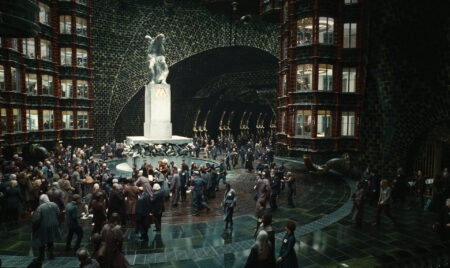In the far reaches of the galaxy, on a distant planet, there exists an enigmatic entity known as the Guardian of Forever. It’s a portal through time, a gateway to other dimensions and realities. Imagine this: Captain Kirk materializes through the portal, followed closely by his ever-logical comrade, Spock, fresh from an adventure among the Orion civilization. But here’s the twist – Dr. Bones McCoy has no idea who Spock is, and neither does anyone else on the starship USS Enterprise.
This intriguing scene, although not part of the five-core Star Trek series, embodies the essence of the Star Trek universe. The Original Series, The Next Generation, Deep Space Nine, Voyager, and Enterprise are all modern classics cherished by fans. Yet, there’s one early Star Trek gem that often goes overlooked – Star Trek: The Animated Series as reported by BBC Culture. A 20-episode wonder that remains uncertain in its canon status, this animated series holds a vital legacy, introducing animation into the franchise while keeping Star Trek alive during transitional periods.
The Genesis of Star Trek: The Animated Series

When The Original Series met its cancellation in 1969, it seemed like the end of the road for Star Trek. However, Gene Roddenberry, the visionary creator of the franchise, wasn’t ready to abandon his dream of a peaceful, diverse sci-fi future. The Original Series might have faced ratings challenges during its initial run, but it thrived in syndication and paved the way for fan conventions – a phenomenon that echoes today’s Comic-Con gatherings. With studios interested in more Star Trek content, there was one significant hurdle: the sets had been dismantled, costumes lost, and rebuilding from scratch would be prohibitively expensive.
NBC decided on an alternative approach – an animated series. Gene Roddenberry, although initially skeptical of an animated show, saw it as a stepping stone to another live-action series or a feature film. Recognizing the potential to energize fans, Roddenberry agreed to The Animated Series, with the condition of having full creative control. After some negotiation, the network acquiesced. The original cast returned, with the exception of Walter Koenig’s Pavel Chekov, cut for budget reasons.
The Animated Series – Not Just for Kids

Star Trek: The Animated Series debuted 50 years ago in September 1973, during Saturday morning cartoons. However, this was no ordinary children’s show; it was conceived as a direct continuation of The Original Series. Some episodes were direct sequels, like “More Tribbles, More Trouble,” a continuation of “The Trouble with Tribbles,” featuring the return of Cyrano Jones. Other episodes, like “How Sharper Than a Serpent’s Tooth” and “The Infinite Vulcan,” displayed the show’s commitment to a traditional, adult Star Trek audience. The latter even saw Walter Koenig himself, writing an episode where a scientist attempts to clone Spock.
Under the leadership of Dorothy (DC) Fontana and a team of original series writers, the show aimed to uphold the mature essence of Star Trek. Despite critical acclaim, the series struggled due to its Saturday morning slot, ultimately leading to its cancellation after two years. Roddenberry then shifted his focus to another live-action series, Phase II, which eventually evolved into Star Trek: The Motion Picture.
For decades, Star Trek: The Animated Series languished in relative obscurity, wedged between the iconic original series and the subsequent success of The Next Generation in 1987. Its animated format and child-friendly airing time led many to dismiss it as mere children’s entertainment. However, recent years have witnessed a renaissance of sorts for The Animated Series.
A New Chapter for an Old Series
The debate over its canonical status remains ongoing. Fans have often considered the show as the latter years of the Enterprise’s five-year mission, while Gene Roddenberry himself didn’t categorize The Animated Series as part of the Star Trek canon. For many years, Paramount respected Roddenberry’s wishes. However, since the revival of the television franchise with 2017’s Star Trek: Discovery, The Animated Series has found its place firmly ensconced within the annals of Star Trek history.
Captain Robert April, a pivotal character in the new series “Star Trek: Strange New Worlds,” debuted as the first captain of the Enterprise in The Animated Series. “Star Trek: Lower Decks,” another animated series that premiered in 2020, regularly pays homage to its animated predecessor. Dr. T’Ana, a Caitian character introduced in The Animated Series, plays a prominent role in Lower Decks. The synergy extends further, as evidenced by the live-action crossover between “Strange New Worlds” and “Lower Decks” in the episode “Those Old Scientists.”
The legacy of Star Trek: The Animated Series is closely intertwined with the current crop of animated shows. While it had its ups and downs, key episodes like “Yesteryear,” where Spock travels back in time to save his childhood self, demonstrated that Star Trek could excel in any format, including animation. However, animation has often been underestimated as a medium for mature storytelling, which contributes to The Animated Series occasionally being overlooked.
A Continuing Voyage
As the world celebrates the 50th anniversary of Star Trek: The Animated Series, its legacy stands as a testament to the in-between periods in Star Trek’s history. While the golden era of Star Trek, with five concurrent shows, may have passed, the future of the franchise remains bright. Rumors of budget cuts led to the cancellation of “Star Trek: Discovery” and the sale of “Prodigy.” However, Star Trek is too significant a property to remain dormant for long. “Lower Decks” bridges the gap between the current shows concluding their runs and the exciting future of Star Trek.
Regardless of its canonical status, The Animated Series embodies the core ethos of Star Trek: Gene Roddenberry’s vision of a utopian future where humans coexist harmoniously with aliens in a Federation free from poverty and war. In this vision, space exploration is driven by scientific and humanitarian ideals. Star Trek: The Animated Series is a welcome reminder of these timeless principles, a long-overlooked gem that continues to inspire and shape the ever-evolving Star Trek universe.













